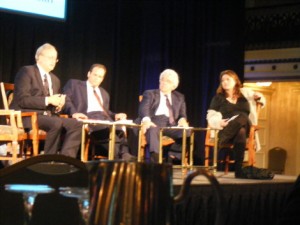DPAA Focus: Media Planners and Buyers
Gail Chiasson, North American Editor
With thousands of digital place-based media screens – run by innumerable small and large networks across the U.S. alone – and found in cafes, restaurants, bars, hotels, airports, retail stores, medical offices, hospitals, drugstores, taxis, campuses, healthclubs/gyms, cinemas and more, everyone recognizes that this growing industry can be a difficult and frustrating advertising buy.
Enter the Digital Place-based Advertising Association with its new tool specially aimed at easing the way for media planners and buyers to sort out what they are looking for and making digital place-based media easier to buy.Developed for the DPAA by Ayuda Media Systems, Montreal, the planning tool, a ‘search and discovery’ tool, will go live on the DPAA website in January and will be offered for free to agencies and their clients. Not limited only to DPAA’s 22 members, any and all networks can be included, paying only the nominal administrative charge averaging about $5,000 per year per network (varying depending upon membership status). The DPAA can supply a rate card, which will also soon be posted on the DPAA website.
The information will be searchable by venue type, location, audience measurement providers, network size, network operator, and will be able to be sorted by audience ratings, composition for 41 demographic breaks, as well as the aforementioned searchable criteria, right down to individual Zip Codes. This Version 1.0 will be further enhanced with more insight over time.
But the new DPAA media planning and buying tool isn’t the only thing helping grow the industry. Added into the mix are the fact that many of the companies are now third party verified and that the industry now can provide solid research figures – along with a mix of case histories of digital buys alone or bolstering mixed media campaigns to successfully build awareness and sales. (And, of course, the newly announced standards for creatives – see our Oct. 28 and Oct. 30 articles.)
 Speaking of research, four companies in this field and whose studies are available each put key people up for a conference panel on the topic. Included were: Paul Linstrom, senior vice-president, Nielsen On Location Media; Jay Matlin, senior vice-president, new ventures, Gfk MRI; Bob Schullman, president, Ipsos Mendelsohn; and Diane Williams, senior media analyst, Arbitron.
Speaking of research, four companies in this field and whose studies are available each put key people up for a conference panel on the topic. Included were: Paul Linstrom, senior vice-president, Nielsen On Location Media; Jay Matlin, senior vice-president, new ventures, Gfk MRI; Bob Schullman, president, Ipsos Mendelsohn; and Diane Williams, senior media analyst, Arbitron.
Each of the companies spoke of their own company’s surveys and studies, and the knowledge and advantages that they can offer agencies. With more studies from these and other research companies, notable Simmons and Scarborough, to come, the industry now has all sorts of resources needed to plan and buy as they would for other media.
Case histories that can actually demonstrate the value of a media are a key selling point when under consideration by planners and buyers. No less than six such cases were demonstrated during the conference. First off in the morning was that of Johnson & Johnson’s Rogaine product, demonstrated by Rich Simpson, the product’s brand manager. (Rogaine got more of its share of awareness – and laughter – among conference attendees the rest of the day as various hair-challenged speakers commented of their need for the product.)
Simpson said that, while Rogaine has a 70% market share, the aim was to keep that momentum, so the strategy was to drive product trial and then keep the user on Rogaine for a good length of time so that it worked properly. It used digital place-based media in health clubs to reach the target, demonstrate, and get users to use the product properly, knowing that many health club members were the potential target and that digital place-based media had a long dwell time in the clubs. Rogaine also distributed coupons for product trial. Simpson gave a lot of detailed numbers, including, among 349 intercept observers, a 50% more favourable impression of the product and 83% interest in buying Rogaine.
Other successful case studies included: TargetCast TCM’s use of Captivate Network in elevators for Hotels.com to differentiate it from competitors; Yahoo!’s use of digital place-based video to lift the use of the search engine; Maker’s Mark’s use of Wall Sreet Journal Office Network to build awareness and trial; The U.S. Army’s use of an interactive game on eCast Network in bars and restaurants to interest the 18-24 market (9,000 people signed up for more information on the army); and Miller Genuine Draft 64’s use of Zoom Media & Marketing and RMG Networks in health clubs to increase awareness and purchase intent. (65% of the targeted 21-49 age group surveyed said that it was a beer that ‘best fits my lifestyle.’)In every case history, the advertiser planned to not only use digital place-based media again but to increase use of the media in the future.
Put all these together, and, with a solid sales effort by its members, we can envision the digital place-based industry surging ahead even faster. Could this be ‘the year of DOOH? Oops! ie. the year of digital place-based media’?



Follow DailyDOOH